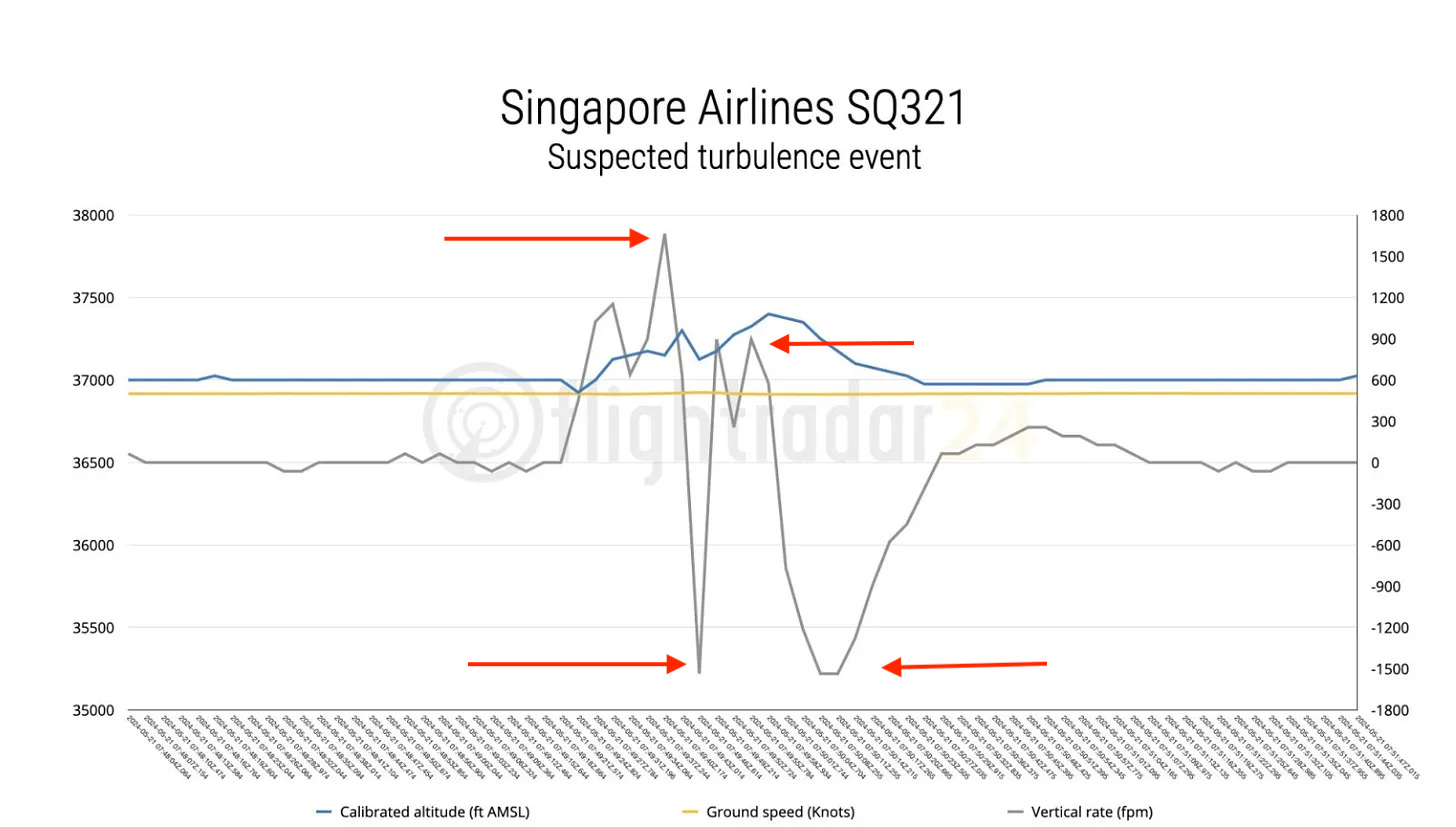The Singapore Airlines Emergency: What Happened, and What Can We Learn?
Apart, that is, from a reminder of the fundamental lesson: Always keep your seat belt on. Some other guides for following the news as it unfolds.
Photo from the Xitter feed of FL360Aero, reported to show the interior of Singapore Airlines flight 321 after its encounter with severe turbulence yesterday. (FL360Aero.)
1) What happened: The big picture.
Ten hours into a long-haul flight from London Heathrow to Singapore Changi airport yesterday, Singapore Airlines flight 321, a Boeing 777, encountered exceptionally violent turbulence. The plane was traveling at a reported altitude of 37,000 feet, had just crossed the Bay of Bengal, and was over a southwestern corner of Myanmar/Burma.
One passenger aboard the plane died, though exactly how and why is not yet clear. More than 80 people aboard were injured. Many were taken to a hospital after the plane diverted to a “medical emergency” landing in Bangkok.1
Both this airline and this model of airplane are highly regarded for safety and reliability. For the moment there is no sign of a problem with the plane, its pilots, its air traffic control instructions, or anything other than the air it was flying through.2
2) What happened: The crucial minute.
The news I saw last night was full of breathless accounts of the Singapore flight descending at “1,000 feet a minute!” as it went from 37,000 feet down to 31,000 feet, and then all the way down to ground level for its landing in Bangkok.
Disregard anything further you hear in this vein. A thousand feet per minute is a perfectly normal descent speed for an airliner. Passengers would barely notice.3
What matters is not the long minutes of the plane’s descent but 20 or 30 seconds in flight. A graph from the invaluable FlightRadar24, assuming that it proves to be accurate, shows how sudden the episode was. This graph looks complicated, but the points marked in red arrows are the keys.
.
In this chart, the blue line is the plane’s altitude, and the yellow line is its ground speed. For now please don’t concentrate on either of them. Look instead at the jagged line in gray. That line follows the plane’s vertical speed, the rate at which it is going up or down. (The numbers on the right-hand axis show this vertical speed, in feet per minute.)
The significance of the chart comes from the points (marked with arrows) where the vertical speed changes, and the plane suddenly shifts from going up to going down, or vice versa. These sudden changes were enough to throw passengers and equipment all around. At the first red arrow, the plane is climbing at more than 1,500 feet per minute. At the next, it’s descending by more than 1,500 feet per minute—a 3,000 foot-per-minute change within just a few seconds. (The barely legible marks at the bottom of the chart are three-second intervals.) Something similar is shown with the other two arrows.
The chart looks like the path of the world’s steepest roller coaster, and that is how it would have felt inside the plane. The difference is that it would have come with zero warning, and inside a cabin full of food, equipment, carts, and people, all about to be hurled into ceilings and walls. That led to the injuries, and to scenes like this one from FL360Aero, reported as showing the plane’s galley.
3) What happened: ‘Surfing through the sky.’
How could the air do this kind of damage?
In thinking about aviation it helps to imagine air as a fluid liquid. Of course it’s a gas, and since you can see right through it you don’t register its fluid nature the way you do with water. [Update: also in the “of course” category, thanks to my friend Jack Wells for the reminder that gases are fluids. “Liquid” was the proper word in the first line of this paragraph. I think the second use of “fluid” is OK.]
But from an airplane’s point of view, the sky is a sea. The airplane “swims” in three dimensions through its aerial ocean. The texture and pressure of the air keeps a plane aloft, through pressure on its wings. A crosswind or headwind affects the plane’s progress, just as an opposing tide would with a swimmer or a boat. A strong enough updraft will lift and propel a plane without any external power. Thus glider planes ride waves in the air, much as surfers ride waves in the sea. A strong enough downdraft can push a plane downward dangerously fast, as a crashing wave can batter a surfer into the beach.
And even though we can’t see it, air can be bumpy. (Think of a gusty wind.) When riding in our family’s little propeller plane through choppy air at low altitudes, I would tell passengers to think of this as riding invisible white-water rapids. If it got too bumpy, I’d remind myself of that too! The plane jounces along its invisible rapids, just as a raft or canoe might. And eventually you come out of the rapids and the ride settles down. (Or, if you’re the Singapore plane, you’re bouncing along the Niagara River—and then you come to the falls.)
Big planes are built to withstand nearly all mid-air turbulence. Small planes can survive most things short of flying right into a thunderstorm. Thus the standard pilots’ line that turbulence feels more dangerous than it is.4
The damage from turbulence is rarely to the airplane itself. It is to those inside, who with no warning are thrown up and down and around, as many on the Singapore flight were.






